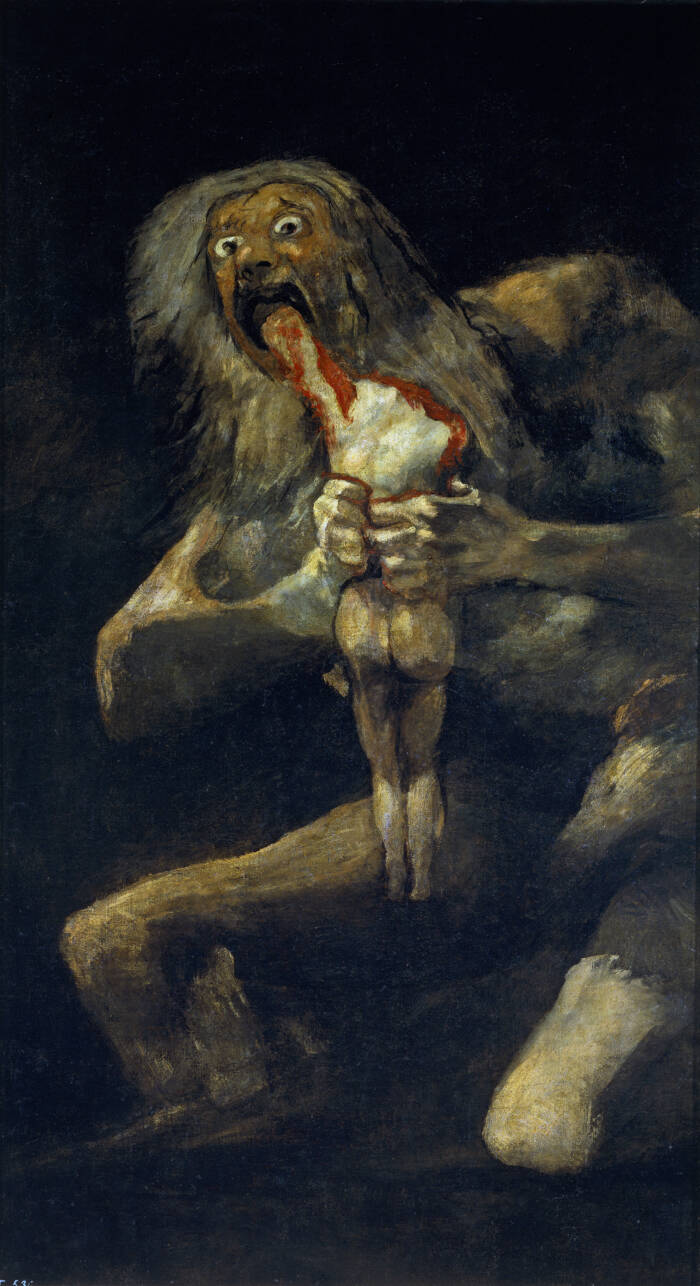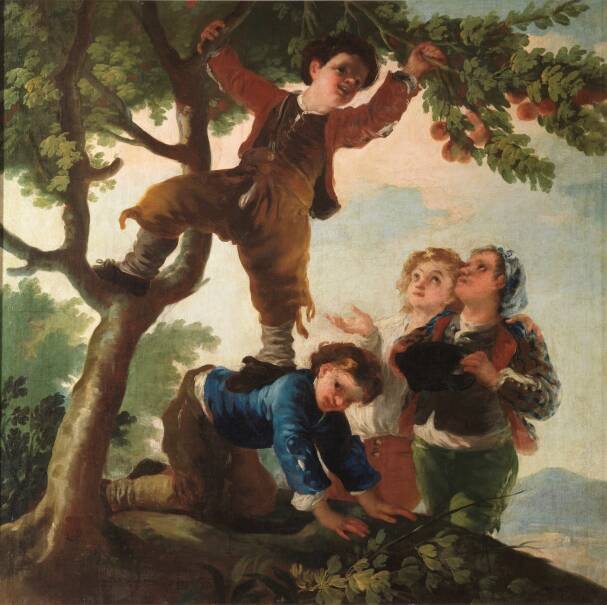Saturn Devouring His Son is one of 18th-century artist Francisco Goya’s Black Paintings, a series of murals he painted directly onto the walls of his home in Spain while in the throes of mental illness.

Wikimedia CommonsFrancisco Goya, Saturn Devouring His Son, c. 1823.
When the famed Spanish artist Francisco Goya died in 1828, a series of 14 unsettling murals were found painted directly onto the walls of his home near Madrid.
As it turned out, Goya had created these paintings in a state of deep depression and paranoia. And one of these works was so violent that it is still referred to as one of the most disturbing paintings in existence.
This is the story of Saturn Devouring His Son and the tortured artist who created it.
The Origins Of The Myth Behind Saturn Devouring His Son
Francisco Goya’s Saturn Devouring His Son features a massive, grotesque humanoid creature with crazed eyes feasting on a nude human figure. The bloodied victim appears to be missing its head and an arm, as if the monster has already bitten these off.
Given its similarities to Peter Paul Rubens’ Saturn, many art experts believe that Goya’s piece, which he apparently never named, could be a depiction of the ancient Greek myth of the titan Cronus and his kin.

Wikimedia CommonsPeter Paul Rubens’ Saturn, c. 1636.
According to the myth, Cronus (or Saturn in the Roman version) — a titan and the father of six of the gods of Olympus — feared a prophecy that foretold his downfall at the hands of one of his children. To prevent this from happening, Cronus devoured every child born to him and his wife, Rhea.
Rhea, desperate to save her children, hid her sixth son, Zeus, on the island of Crete. She fooled Cronus by giving him a large stone wrapped in a swaddle in Zeus’ place. Cronus unwittingly ate the stone instead of his son. This treachery would result in Zeus’ eventual triumph over Cronus.
If early theories are to be believed, Saturn Devouring His Son shows the titan eating one of his own children. However, not everyone is convinced by this interpretation.
The Disturbing Interpretations Of Goya’s Work
Some historians are confident that Goya’s Saturn Devouring His Son depicts this ancient Greek myth. However, there are some important discrepancies between the painting and the story.
According to Hesiod’s Theogony, an ancient poem exploring the origins of the Greek gods, Cronus would swallow his infant kin whole rather than tear them apart.
The dismembered figure in the painting also appears both fully grown and feminine in form, contradicting the notion that the painting depicts Cronus’ ire toward his young sons.
Additionally, some art historians believe that the figure of “Saturn” may have been originally painted with an erect penis. It’s possible that this detail was lost due to natural deterioration over time, or that someone deliberately painted over it.
Because of these considerations, some art historians argue that the painting is a representation of masculine sexual violence. As John J. Ciofalo writes in his book The Self-Portraits of Francisco Goya:
“The overwhelming feeling of the image is one of violent and insatiable lust, underscored, to put it mildly, by the livid and enormously engorged penis between his legs… Utter male fury has hardly before or since been captured so vividly.”
Others have suggested that Saturn Devouring His Son is an expression of antisemitism, as depictions of Jewish men eating children were common in European art at the time.
However, Goya neglected to leave any notes or descriptions of the work, likely because he never intended to show it publicly. This leaves the painting’s interpretation up to the viewer.
And when the piece was first revealed to the public, many viewers did not look upon it favorably.
Discovering Saturn Devouring His Son

Public DomainThe Quinta del Sordo, Francisco Goya’s home near Madrid.
Francisco Goya died in 1828. Afterward, his Spanish home changed hands multiple times until it was purchased in 1873 by a French banker Baron named Frédéric Émile d’Erlanger. Apparently seeing something of value in the 14 murals adorning the home’s walls, he decided to preserve them.
D’Erlanger called on Salvador Martínez Cubells, the chief art restorer at the Museo del Prado, to remove the murals from the walls and transfer them to canvas — a painstaking process that undeniably damaged the original artworks.
Now more easily accessible and transportable, Goya’s murals appeared at the 1878 World’s Fair in Paris.
Early viewers of Saturn Devouring His Son were highly critical of the piece, with one critic calling it “disgusting without much art,” according to the Museo del Prado’s website.
Another critic, British art enthusiast PG Hamerton, spoke strongly against the paintings at the Paris exhibition, casting Goya as a “hyena” and calling his imagination “a hideous inferno… a disgusting region… shapeless as chaos,” according to The Guardian.
Today, the Museo del Prado displays the mural, as well as hundreds of Goya’s other works, for visitors to interpret for themselves. And despite the intense visceral reactions it initially inspired in viewers, Saturn Devouring His Son has endured as a masterpiece that reveals haunting insights about the dark interior life of its creator.
Who Was Francisco Goya?

Wikimedia CommonsA portrait of Francisco Goya by Vicente Lopez (1826).
In order to understand why an artist would create such a disturbing piece as Saturn Devouring His Son, one must examine their life. And Francisco Goya’s was certainly one of extreme ups and downs.
Born in 1746 in Spain, Goya studied under famous Spanish painters in his youth and quickly established himself as one of the most esteemed artists of his time. By 1786, Goya became a royal court painter, creating works in the Romantic and Rococo style depicting life in the court.

Museo del PradoBoys Picking Fruit by Francisco Goya, 1778.
While Goya’s early artwork was lighthearted and carefree, his paintings became more somber after an illness left him nearly deaf in 1793.
When the French invaded Spain in 1807, his work became darker still, probably due to trauma from the conflict. The violence likely inspired Goya’s grim series titled The Disasters Of War. Goya also began exploring subjects like mental asylums, witches, and religious corruption in his paintings.
By the early 1800s, Goya reportedly began to suffer from hallucinations and paranoia. His mental health had reached a low point around 1819, when he purchased the Quinta del Sordo near Madrid.
Between 1819 and 1823, in a state of deep depression and perhaps even madness, Goya produced a series known as his “Black Paintings,” 14 murals created directly on the plaster walls of his home. He would later abandon the house to spend his final years in Bordeaux, France. He died in 1828 without ever writing — or perhaps even speaking — of his Black Paintings.
These murals, which include Saturn Devouring His Son, are sometimes referred to as the most disturbing series ever painted.
“Some people can hardly even look at them,” Teresa Vega, an art historian at the Museo del Prado, told The Guardian in 2019. “I’ve had plenty of clients who didn’t like them at all. But when they walk in, they are always surprised. I don’t think I’ve ever seen a visitor whose expression hasn’t changed. Even a yawning teenager will wake up when they see them.”
The power of Francisco Goya’s Saturn Devouring His Son, and the rest of the Black Paintings, does not lie solely in the dark subject matter of the work, but also within the stark contrast between the art produced in one man’s youth and in his old age.
For some viewers, the Black Paintings depict an evil so unsettling that it is hard to believe it was contrived from one man’s experience with real human horrors. But Goya’s own words give perhaps the best insight into his frame of mind. As he wrote in the description of his Capricho series:
“When abandoned by Reason, Imagination produces impossible monsters.”
After reading about Francisco Goya’s disturbing mural, discover the stories behind nine cursed paintings. Then, dive into the mystery of Kindlifresserbrunnen, the strange child-eating statue of Bern, Switzerland.





